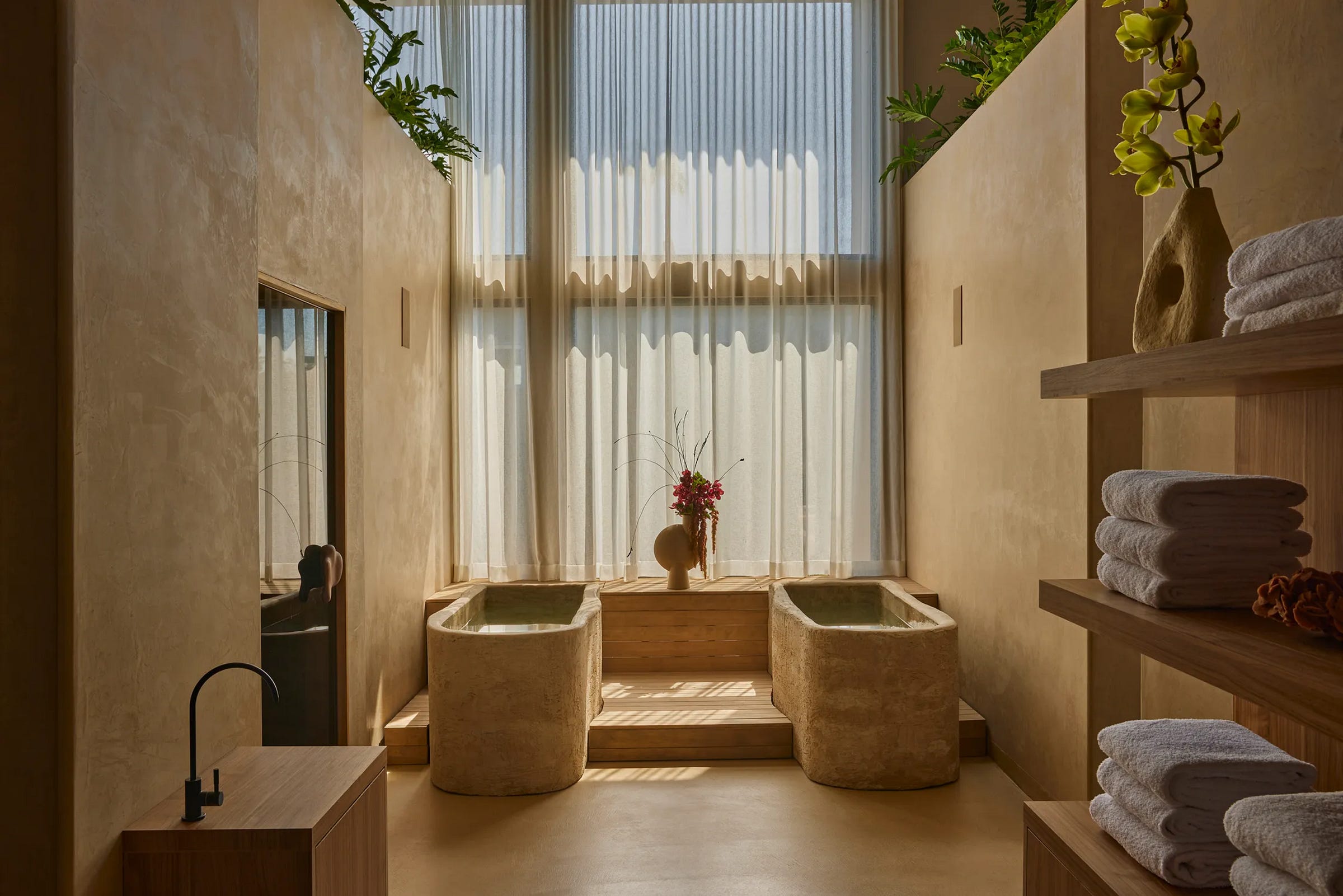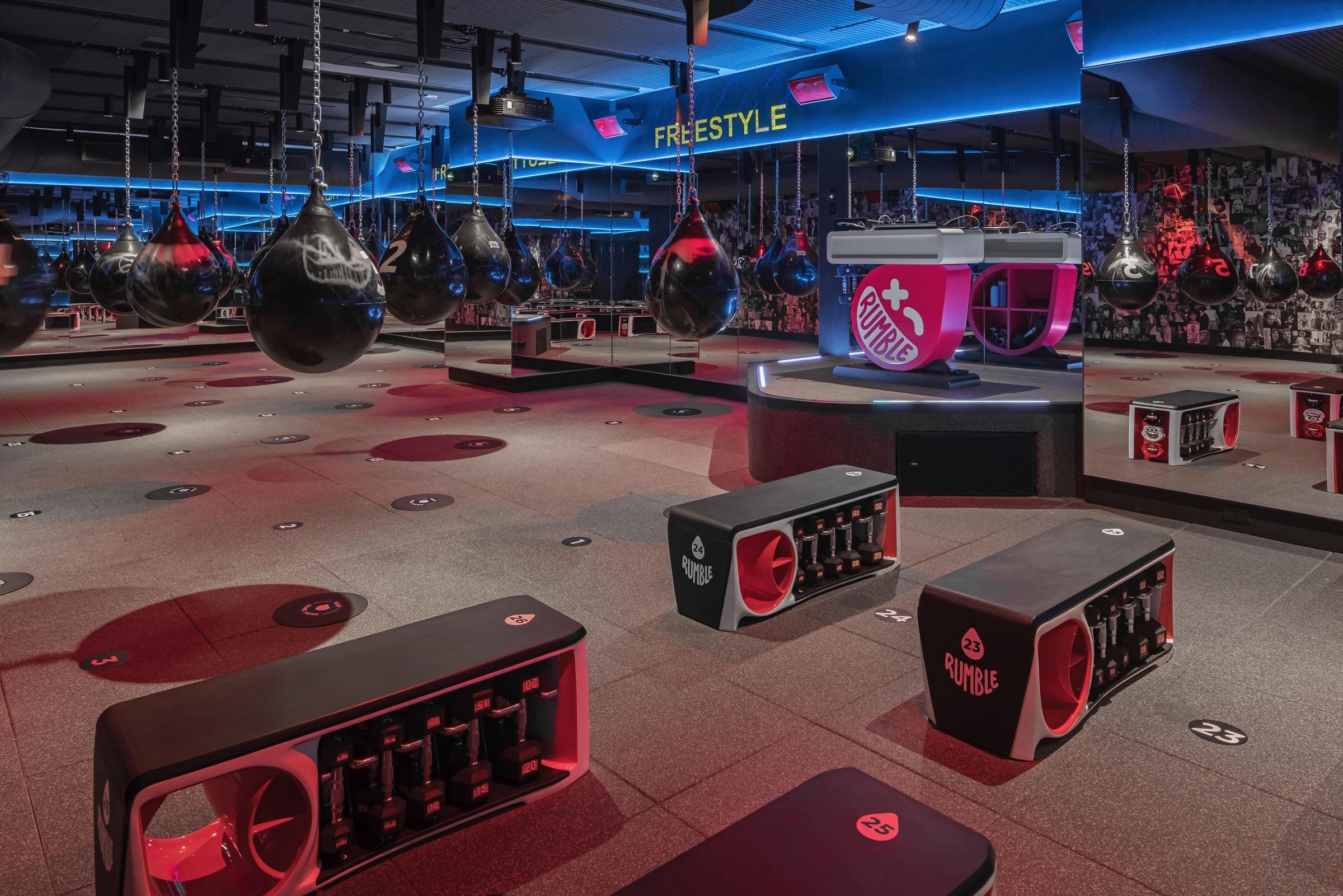Let’s be honest: the average fitness space is an afterthought. Whether it’s in a residential building, a private club, or a so-called wellness resort, the setup is usually the same—same cardio and weights, with the occasional moments of thoughtfulness. It’s a checkbox, not a strategy; a space people tolerate, not a space they love. But guess what? SPX doesn’t do average.
We sat down with Frank Englund and Chris Howell, co-founders of SPX, the creative studio behind some of the most thoughtful, culture-forward fitness and wellness spaces in hospitality, multifamily, and members’ clubs. From custom millwork to branded dumbbells to neighborhood storytelling, they’ve helped redefine what a “gym” can be and what it can mean.
Like us, they believe fitness and wellness spaces are some of the most emotionally charged, personally meaningful environments in any project. They’re not just places where people “work out.” They’re where routines are formed, anxiety is burned off, jet lag is managed, and moments of growth—physical or otherwise—actually happen.
That kind of space deserves better thinking. Better design. Better storytelling.
We wanted to understand how they think about programming, brand, and why so many developers still get it wrong. And maybe, just maybe, what White Lotus got right.
Let’s get into it.
Frank Englund & Chris Howell
Co-Founders, SPX
NWS: Let’s start with a softball. Why Gym and Wellness? You could have chosen all sorts of amenity spaces. What made you gravitate towards this genre? Why is this type of space important?
Frank: Originally this stemmed from a personal love for fitness & wellness. I worked as a personal trainer for over a decade and managed a few gyms—knew that isn’t exactly what I wanted to do, but I had a love for this industry and found my passion in fitness & wellness spacial planning, design, & operations. When we started, the hospitality & multifamily space was such an obvious hole in the market, with their wellness amenity spaces often slated as an afterthought or low on the priority list. A box they needed to check. The industry is evolving so rapidly and for these groups to stay competitive or get a leg up on their competition they had/have to prioritize these spaces.
Chris: We started SPX in 2016, when hotel and multifamily gyms were usually just a few dumbbells, a treadmill, and a yoga mat in the corner. We felt that the “hotel gym” and “apartment gym” could—and should—be better. Some forward-thinking hospitality groups saw the same potential we did, and we got to work. These spaces are important because they’re often the only place someone has for movement and health during their stay or daily routine. That deserves thoughtful design.
NWS: One of the things we struggle with is amenities that feel like add-ons or after-thoughts or even requirements for Keeping up with the Joneses. We hear developers say:“I know I know I need a badass gym – here’s the general allocation” but nothing more. How do you think about the idea of amenities in terms of the larger concept of the space?
Frank: It comes down to defining the identity of your space and the avatar you are looking to attract. In today’s market, often the higher spending guests and residents are also those who are prioritizing their health & wellness. They prioritize these spaces as one of the first things they look for when deciding where to stay or live. My view is developers need to focus less on what their competition is doing and more on what the people they are trying to attract want. Just because your competition is doing something doesn’t mean it's the right thing for you and your concept/offering.
Chris: I think the building is a reflection of the developer. We can usually tell early on whether the gym is going to be a box to check or a true part of the building’s DNA. When it’s treated as an afterthought, it feels disconnected from the rest of the project. But when the gym is a priority, it often matches the quality and thoughtfulness of spaces like the lobby—and that’s when tenants rave about it. It becomes a signature, not an accessory.
NWS: We think that the story of the brand should show up in every aspect of the space. What kind of stories can Fitness / Wellness amenity spaces tell? What’s an example of a space in this category that tells a particularly compelling story? How does the story shine through?
Frank: You want your brand and design to show up in every aspect of the guest experience. From the moment they book online, to when they check in at the front desk, to when they are sitting in the lounge/cafe, to when they enter the gym/wellness areas. Groups often don't understand the branding opportunities that can live within these spaces. Custom colors, logos, fonts, upholsteries…you can make your space 1 of 1, so even if someone tried to copy you, they can’t. We have worked heavily on helping curate custom millwork and storage pieces for gym spaces with groups that tie into millwork and storage within rooms and other areas of the property, and have received tons of feedback that it makes the gym feel “homier”—creating a comfortable environment where the guest feels more at home in the space. The more comfortable someone feels with the fitness & wellness spaces, the more likely they are to engage—even when it's with something not as obvious as a logo on a dumbbell or custom upholstery on a bench.
Chris: We love finding ways to weave in the local narrative. One project in London stands out—we sourced the dumbbells from a guy literally down the road. It wasn’t just equipment, it was a story. Staff had something to talk about. Guests felt like they’d stumbled onto a secret. And that’s the magic—the little moments that say, “Hey, this place isn’t like the last five hotels you stayed at.”
NWS: Our relationship to fitness / wellness changes based on context: the way we experience a gym–for example–at a resort should be different from the way we train in the gym in our neighborhood. It doesn’t feel like the market has picked up on the set-shifting of these designs to meet our different needs. What do you think about that idea? What should people think about when designing for different contexts?
Frank: Couldn’t agree more. Regardless of where someone is training, they are going to look for a certain level of familiarity with some standard pieces across cardio & strength. Once those standard pieces are satisfied, depending on the location/concept/context, that’s where you have the opportunity to branch out and customize selections based on the experience you want to provide. When someone is on vacation, they are much more likely to try and experience something new.
Chris: Exactly. Context is everything. At a resort, people are out of their routine— open to new ones. That’s your shot to introduce something fresh. Maybe they try sunset yoga for the first time, maybe they do a “workout of the day” board and feel like an athlete. That’s huge. But we have to also design it like every person is walking in for the first time—because they are. The layout has to be intuitive. No scavenger hunts for dumbbells.
NWS: What about how fitness / wellness designs relate to different types of users? It feels like every gym we walk into has the archetype of the jacked dude swinging heavy bands and moving monster truck tires in mind when they design. How are you centering your design on different audiences?
Frank: The days of the cheesy ads of a jacked guy or girl curling a dumbbell are over. If someone is still running that as their primary brand image, they are dead in the water in my opinion. It's not relatable, and not aspirational. Curating spaces where the environment is inviting to men and women of all ages, while ensuring the equipment can service the really intense gym goer, but isn't too intimidating for my 70 year old aunt to use. We spend a lot of time on finding/creating this balance. Marrying form vs function is the key. Something that is beautiful and aesthetically pleasing, but also a gym that has an environment that makes you want to workout, sweat, exert effort. We see a lot of concepts that hit one of the spectrum vs the other. A gym with black walls, black flooring, with black equipment and hard rock or hip hop blasting on the speakers vs a gym that is overly designed with leather wrapped dumbbells, chrome kettlebells and plants everywhere that feels like more of an art gallery than a gym. The key is finding the guest profile the client is looking to service and splitting the difference between the two.
Chris: We design for the real people using the space. Not just the guy flipping tires and sweating through concrete. If it’s multifamily, we’re thinking about the target demographic whether it's a 65 year old navigating their fitness journey for the first time, next to a 25-year-old marathoner. The goal is inclusivity without making it feel watered down. Zones, clear signage, intuitive flows. It’s not about removing challenges—it’s about removing intimidation.
NWS: Let’s talk White Lotus. Obviously Wellness Retreats are having their moment…White Lotus sent the trend into escape velocity. What are some trends that the show picked up on that actually have some grounding in your work? Anything–from your industry perspective– that made you laugh out loud?
Chris: White Lotus didn’t just reflect the wellness trend—it shot it into orbit. The whole resort-as-self-discovery narrative, the curated escapism, the performative “healing” experiences—it’s all there. And honestly? A lot of it’s spot-on.
You’ve got guests treating the spa menu like a spiritual checklist: cryotherapy, chakra alignment, sound bath with artisanal gongs. Half of it is real (well real that it occurs, not that it works), half of it’s theater—but that’s the business now. People want transformation and a selfie with the plunge pool. The sad part…lack of gyms. I guess just like in reality at these places.
NWS: As we always do, we’re going to put you on the spot and on the record here: what’s your favorite fitness / wellness space in the world and why? What can we learn from that space?
Frank: There is a project we are working on in FL right now that I can't disclose that I am really excited about. The perfect blend of fitness, wellness, longevity & hospitality wrapped under one roof. The gym will be beautifully designed, but still have the raw elements real gym goers look for to get some real work in. The wellness space will be a serene, calming environment with all of the wellness elements you could ask for. Perfect blend of functionality and design. You’ll see more information come out about this space later this year.
Chris: My home gym. Ha. I think everyone has their own preferences and things that make health and wellness a part of their lives.
NWS: More on this topic: who's moving the needle on fitness / wellness? Who should we all be looking at for inspiration? Any brands or experiences that fall outside of that explicit category that are inspiring you?
Frank: Historically, fitness, wellness, longevity, & hospitality all operated as independent industries from one another. Groups that are able to wrap these elements together in one offering are the ones I believe will be truly relevant 5-10 years from now. There is a concept called Moss we are working with that is opening in NYC later this year that will be doing just that—I think there will be a lot of people looking at them for inspiration once they open.
Chris: I love seeing hotels open their wellness spaces to local members—it brings in the community, gives the space more rhythm, and turns what used to be a sunk cost into a real revenue stream. On the multifamily side, there’s a huge opportunity to rethink the gym as more than just a checkbox—it can become a true lifestyle hub if it’s designed with purpose.
Outside the fitness world, I get a lot of inspiration from automotive and hospitality. Scout Motors, for example—the way they’re reimagining a classic brand is creative and intentional. And I recently went to The Masters, which, honestly, might be the best-run event I’ve ever attended. The hospitality was flawless—from the exclusivity to the history, they know for most people it’s a once-in-a-lifetime experience, and they design everything around that idea. That level of intentionality is what we aim for in our spaces.
NWS: We’re all about creating spaces that people love. We know that most spaces fall woefully short of consumer expectations – and there are very few aspects of our spaces that we hold to higher standards than fitness / wellness. What is everyone getting wrong? How do we get those things right? Any nifty frameworks or ways of thinking that we should take home with us?
Frank: Assuming a group is trying to put some real thought and effort into their spaces—we sometimes see groups that can create a beautiful environment within the gym, but the equipment itself stands out like a sore thumb. These groups are so accustomed to going to one equipment vendor to outfit their space, vs curating the equipment piece by piece to fit the design narrative and guest experience they are going for. I think groups often miss the mark and don’t take the time to curate the equipment and just check the box.
Chris: People overcomplicate it. Or worse—they just copy what they saw in another building and call it a day. The approach should be the same as designing a beautiful lobby or restaurant—you plan for flow, mood, experience. If someone walks into your gym and feels confused or excluded, that’s the whole project lost.
NWS: Final question: are there any specific projects or concepts you’ve always wanted to work on but haven’t had the chance to (yet)? We all have those dream projects we’d love to see come to life.
Frank: I am at the early stages of working on something now that will check this box, but I feel like there is a huge gap in the market in tier 2-3 cities or high income suburbs for larger concepts that could change the game. So many groups want to be in the tier 1 cities like NYC/LA/Miami, and overlook opportunities in these secondary markets that have the appetite and right demographic to be successful. I would love to work on some of these spaces that put some of these areas on the map within this industry.
Chris: I’d love to work on a tropical resort from the ground up—where wellness isn’t bolted on, it’s baked in. Somewhere people come ready to try something new, maybe reinvent themselves a little. Taking a historically underwhelming experience and flipping it on its head—and just leave a guest completely wow’ed and have them talk endlessly about how they are going back.
👉 For more from Chris and Frank, follow SPX on Instagram and Linkedin, and certainly check out their latest work at corner-booth.com.
Missed our latest article? Read it now.
Design for Humans
We tour buildings across the country. Statement apartment towers, boutique hotels, cutting-edge offices. And too many times to count, the first thing we notice is the smell. Not a subtle signature scent. Not fresh air. Not even food from the lobby café.
🚨 WHO IS NO WALLS STUDIO (AND WHAT DO WE DO)?
No Walls Studio is a design and brand consultancy that helps real estate developers create spaces that people love.
Our mission is to make sameness extinct in real estate, which means that everything we do comes with new ideas and unique angles — all, grounded in a deep understanding of culture and consumers.
We do three things for our clients (often, all in the same project):
Research & Insights
Brand Development
Spatial Experience Design
Want to work with us or learn more?






















